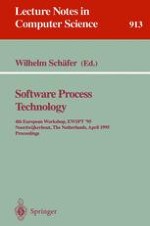This volume presents the proceedings of the Fourth European Workshop on Software Process Technology, EWSPT '95, held in Noordwijkerhout, The Netherlands in April 1995.
The book contains 28 revised full research papers selected from a total of 50 submissions; in addition, the session chairpersons contributed 7 short surveys on the topics treated. Among the issues addressed are analysis and metrics, application experiments, language experiments, models for distributions, mechanisms for cooperation, and change and meta-processes. This book documents that software process technology has become a key technology to cope with the challenges of team-oriented production of large and high-quality software systems.
